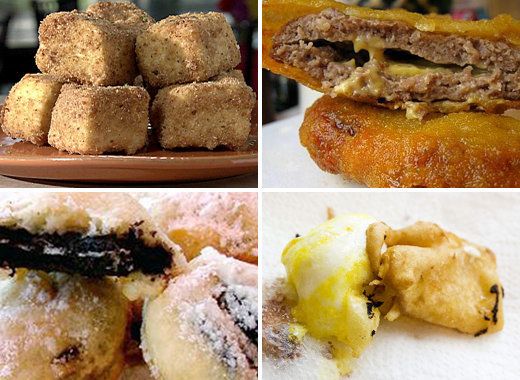Are any guilty pleasures guiltier than deep-fried food? In the face of obesity and heart disease, defending glazed donuts and fish-and-chips feels like defending child abuse.
But deep-fried food, done right, can sometimes be less greasy than sautéed food. It's a scientific thing, a matter of chemistry and thermodynamics.
Bheh kofta was on the seasonal menu last night at Ajanta Restaurant in Berkeley, California. Its description -- "Balls made with boiled, diced lotus roots, potatoes, breadcrumbs and spices, served in a creamy curry sauce" -- was tempting. Given any menu, anywhere, I will always choose whatever is ball-shaped. Who knows why. About to order the kofta, I quailed because I knew they were deep-fried.
Ajanta's owner (and the author of Ajanta: Regional Feasts of India), Lachu Moorjani, told me not to fret.
Before getting into the restaurant business, Moorjani was an industrial engineer.
"My job was to concern myself with the productivity of a factory cafeteria in India. I did a lot of research at that time and discovered that if you deep-fry food at a high enough temperature, it uses remarkably little oil."
Because oil transfers heat much more rapidly than either air or water do, it cooks food faster -- not by saturating the food in grease but rather by effectively steaming the food from the inside out. A 345-to-375-degree oil bath rapidly heats any water contained by food immersed in it, creating a rush of water vapor that flows outward from the center of the food as it meets and repels the incoming oil, ideally preventing its full penetration. As the vapor escapes, a crispy crust forms to coat the food.
Via a process known as the Maillard reaction, the intense heat causes carbon molecules in the sugars to combine with amino acids in the proteins on the surface, creating a distinctively "toasty" flavor, fairground fragrance, and golden hue. Inside -- if done right -- the deep-fried item is moist but not greasy.
In his research as an engineer, Moorjani measured the quantities of oil used in deep-frying and sauteeing equivalent portions of food and found that sauteeing sometimes used more.
At Ajanta, food is fried at very high temperatures using fresh canola oil that is replaced daily to keep it fresh. Oil oxidizes easily and quickly: After a remarkably short time -- and certainly when it is used and re-used for days on end -- it not only takes on the smells and tastes of whatever has been cooked in it but also becomes high in those menacing molecules known as free radicals. I'm no chemist, but commercial cooking oils that are marketed to restaurants with "extended life" as a selling point are worrying.
Some say we would be wise to eat less oil in general, at least less of certain varieties of oil and any oil that has been left to sit around. But some of us cannot help but sometimes take comfort in the golden stuff.
Served in a thick tomato-yogurt sauce, the kofta were transcendent, actually like food in dreams: daintily crispy outside, nutty-crunchy-satiny yet refreshingly moist and not oily inside. If Tater Tots could become lush and elegant and real and Indian and pure, they would be these. Each bite was ohmygod. Or, this being Indian food, ohmygods.
Images courtesy of Kristan Lawson
Support HuffPost
Our 2024 Coverage Needs You
Your Loyalty Means The World To Us
At HuffPost, we believe that everyone needs high-quality journalism, but we understand that not everyone can afford to pay for expensive news subscriptions. That is why we are committed to providing deeply reported, carefully fact-checked news that is freely accessible to everyone.
Whether you come to HuffPost for updates on the 2024 presidential race, hard-hitting investigations into critical issues facing our country today, or trending stories that make you laugh, we appreciate you. The truth is, news costs money to produce, and we are proud that we have never put our stories behind an expensive paywall.
Would you join us to help keep our stories free for all? Your contribution of as little as $2 will go a long way.
Can't afford to donate? Support HuffPost by creating a free account and log in while you read.
As Americans head to the polls in 2024, the very future of our country is at stake. At HuffPost, we believe that a free press is critical to creating well-informed voters. That's why our journalism is free for everyone, even though other newsrooms retreat behind expensive paywalls.
Our journalists will continue to cover the twists and turns during this historic presidential election. With your help, we'll bring you hard-hitting investigations, well-researched analysis and timely takes you can't find elsewhere. Reporting in this current political climate is a responsibility we do not take lightly, and we thank you for your support.
Contribute as little as $2 to keep our news free for all.
Can't afford to donate? Support HuffPost by creating a free account and log in while you read.
Dear HuffPost Reader
Thank you for your past contribution to HuffPost. We are sincerely grateful for readers like you who help us ensure that we can keep our journalism free for everyone.
The stakes are high this year, and our 2024 coverage could use continued support. Would you consider becoming a regular HuffPost contributor?
Dear HuffPost Reader
Thank you for your past contribution to HuffPost. We are sincerely grateful for readers like you who help us ensure that we can keep our journalism free for everyone.
The stakes are high this year, and our 2024 coverage could use continued support. If circumstances have changed since you last contributed, we hope you’ll consider contributing to HuffPost once more.
Already contributed? Log in to hide these messages.

